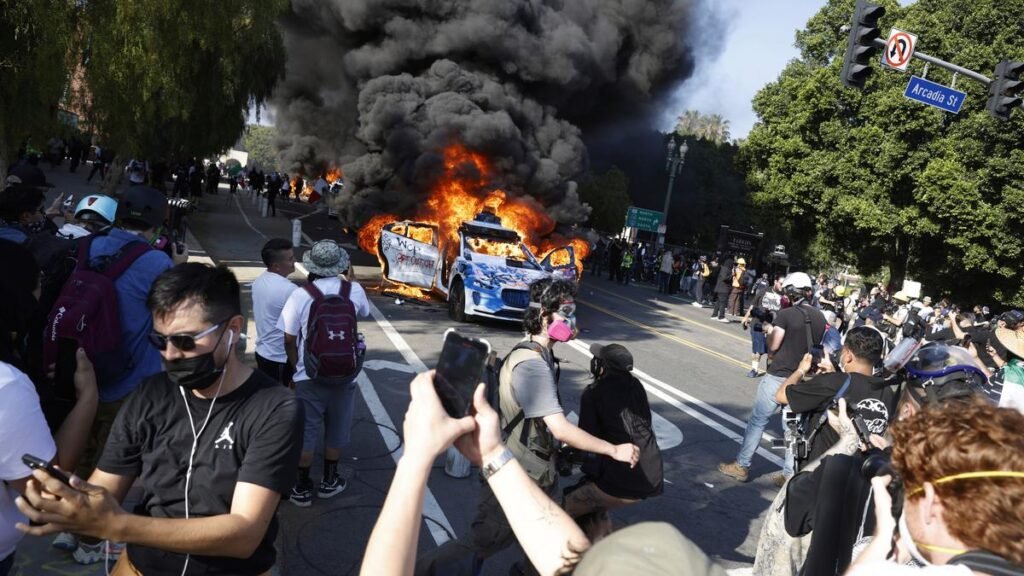
Several Waymo cars were burnt and vandalised in downtown Los Angeles by protesters reacting to a series of immigration raids that occurred in Los Angeles, California, on June 8, 2025.
| Photo Credit: AP
A series of immigration raids conducted by federal agents last week has triggered large-scale protests across Los Angeles, prompting President Donald Trump to deploy thousands of National Guard troops and U.S. Marines to the city, a move that has ignited a legal and political confrontation with California’s leadership.
Also Read: Governor Newsom says ’democracy is under assault’ in response to Trump’s military deployment in LA
Why are people protesting in Los Angeles?
The unrest began on June 6, when agents from U.S. Immigration and Customs Enforcement (ICE) swept through multiple neighbourhoods in and around downtown Los Angeles. Over 100 undocumented immigrants were detained in a matter of hours. The raids were part of a broader immigration enforcement strategy that federal officials said aimed to meet a daily national target of 3,000 arrests.
Within hours, demonstrators began gathering outside ICE offices and City Hall. The protests grew over the weekend, swelling to thousands of people, immigrant rights activists, students, clergy, and families, demanding an immediate halt to the raids and calling for the release of those detained.
The protests are rooted in long-standing tensions over immigration policy in the United States, but have been intensified by what many view as excessive and unaccountable federal action. Los Angeles, a city with a significant immigrant population, has historically resisted federal immigration crackdowns, often positioning itself as a sanctuary city.
California Governor Gavin Newsom and Los Angeles Mayor Karen Bass have criticised the decision as unconstitutional and politically motivated, and the state has filed a legal challenge to prevent federal troops from performing law enforcement duties on California soil.
Where are the protests in Los Angeles, and what’s happening now?
Protest sites have expanded rapidly across Los Angeles, with significant turnouts observed in downtown districts, immigrant-dense neighbourhoods such as Boyle Heights, and along major city arteries like Wilshire Boulevard. Protesters have also gathered outside federal buildings, transportation hubs, and educational institutions, creating both symbolic and logistical disruptions.

The response from law enforcement has included curfews in select areas, increased deployment of riot control units, and cooperation between local police and federal agencies. The presence of military personnel and vehicles in public areas has added to the growing sense of unease.
A federal hearing on the legality of the troop deployment is scheduled for June 12, and the outcome is expected to influence how similar situations may unfold in other parts of the country.
Why anti-immigration crackdown targets Los Angeles?
Los Angeles is home to one of the largest undocumented immigrant populations in the United States, with estimates placing the number in the hundreds of thousands. The city has previously adopted sanctuary policies that limit cooperation between local law enforcement and federal immigration authorities. In recent years, Los Angeles officials have declined to participate in federal immigration sweeps and have implemented local ordinances that restrict the sharing of information with ICE.
Who has been detained and how is the country responding?
Among the roughly 118 to 154 people detained so far, immigration authorities arrested a diverse mix of undocumented individuals, including long-term residents, day labourers, and those with lapsed asylum or DACA status. High-profile arrests include that of David Huerta, president of the California chapter of the Service Employees International Union, who was jailed on charges of “conspiracy against federal authorities.” Several detainees were allegedly deported within 48 hours, among them, Juan Fernando, a 21-year-old Zapotec speaker from Mexico.
The deployment of over 4,000 National Guard troops and 700 Marines to Los Angeles under Title 10 authority has been criticised by California Governor Gavin Newsom and Mayor Karen Bass, who argue that the federal presence bypasses state jurisdiction.
President Donald Trump has defended the actions, describing the protests as “orchestrated unrest” and stating that the federal government “will not tolerate lawlessness.”
Published – June 11, 2025 02:10 pm IST


